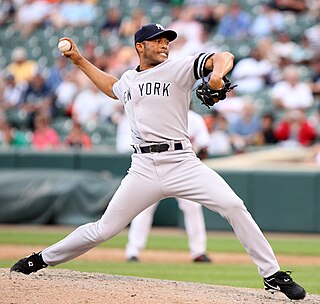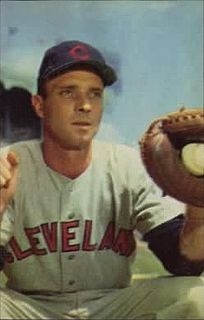Related Research Articles
Baseball statistics play an important role in evaluating the progress of a player or team.
In baseball, an earned run is any run that was fully enabled by the offensive team's production in the face of competent play from the defensive team. Conversely, an unearned run is a run that would not have been scored without the aid of an error or a passed ball committed by the defense.
Sabermetrics is the empirical analysis of baseball, especially baseball statistics that measure in-game activity.
In baseball and softball, a win–loss record indicates the number of wins and losses credited to a pitcher. For example, a 20–10 win–loss record would represent 20 wins and 10 losses.

In baseball, a save is credited to a pitcher who finishes a game for the winning team under certain prescribed circumstances. Most commonly a pitcher earns a save by entering in the ninth inning of a game in which his team is winning by three or fewer runs and finishing the game by pitching one inning without losing the lead. The number of saves or percentage of save opportunities successfully converted are oft-cited statistics of relief pitchers, particularly those in the closer role. The save statistic was created by journalist Jerome Holtzman in 1959 to "measure the effectiveness of relief pitchers" and was adopted as an official MLB statistic in 1969. The save has been retroactively measured for pitchers before that date. Mariano Rivera is MLB's all-time leader in regular-season saves with 652, while Francisco Rodríguez earned the most saves in a single season with 62 in 2008.
In baseball, value over replacement player is a statistic popularized by Keith Woolner that demonstrates how much a hitter or pitcher contributes to their team in comparison to a replacement-level player who is an average fielder at that position and a below average hitter. A replacement player performs at "replacement level," which is the level of performance an average team can expect when trying to replace a player at minimal cost, also known as "freely available talent."
In baseball statistics, pitch count is the number of pitches thrown by a pitcher in a game.
In baseball, defense-independent pitching statistics (DIPS) measure a pitcher's effectiveness based only on statistics that do not involve fielders. These include home runs allowed, strikeouts, hit batters, walks, and, more recently, fly ball percentage, ground ball percentage, and line drive percentage. By focusing on these statistics, which the pitcher has almost total control over, and ignoring what happens once a ball is put in play, which the pitcher has little control over, DIPS can offer a clearer picture of the pitcher's true ability.

In baseball, the dead-ball era was the period from around 1900 to the emergence of Babe Ruth as a power hitter in 1919, when he hit a then-league record 29 home runs. This era was characterized by low-scoring games and a lack of home runs. The lowest league run average in history was in 1908, when teams averaged only 3.4 runs per game. Teams played in spacious ball parks that limited hitting for power, and, compared to modern baseballs, the ball used then was "dead" both by design and from overuse. In addition, ball scuffing and adulteration by pitchers was not against the rules during this period.

Baseball Prospectus (BP) is an organization that publishes a website, BaseballProspectus.com, devoted to the sabermetric analysis of baseball. BP has a staff of regular columnists and provides advanced statistics as well as player and team performance projections on the site. Since 1996 the BP staff has also published a Baseball Prospectus annual as well as several other books devoted to baseball analysis and history.
Robert "Voros" McCracken is an American baseball sabermetrician. "Voros" is a nickname from his partial Hungarian heritage. He is widely recognized for his pioneering work on Defense Independent Pitching Statistics (DIPS).

Carlos Joaquín Ruiz, nicknamed "Chooch", is a Panamanian former professional baseball catcher. He played in Major League Baseball (MLB) for the Philadelphia Phillies, Los Angeles Dodgers, and Seattle Mariners. Ruiz stands 5 ft 10 in (1.78 m) tall, and weighs 215 pounds (98 kg). He bats and throws right-handed.
PECOTA, an acronym for Player Empirical Comparison and Optimization Test Algorithm, is a sabermetric system for forecasting Major League Baseball player performance. The word is a backronym based on the name of journeyman major league player Bill Pecota, who, with a lifetime batting average of .249, is perhaps representative of the typical PECOTA entry. PECOTA was developed by Nate Silver in 2002–2003 and introduced to the public in the book Baseball Prospectus 2003. Baseball Prospectus (BP) has owned PECOTA since 2003; Silver managed PECOTA from 2003 to 2009. Beginning in Spring 2009, BP assumed responsibility for producing the annual forecasts, making 2010 the first baseball season for which Silver played no role in producing PECOTA projections.

James Edward Hegan was an American professional baseball player, coach, and scout. He played for 17 seasons as a catcher in Major League Baseball (MLB) from 1941 to 1942 and 1946 to 1960, most notably for the Cleveland Indians with whom he won a World Series in 1948. Although Hegan was a light-hitting player, he was notable for being one of the best defensive catchers of his era and a capable handler of pitching staffs, earning five All-Star selections. After retiring as a player, he continued to serve as a major league coach in a baseball career that spanned almost 40 years.
Craig R. Wright pioneered the use of sabermetrics in major league baseball, and is a baseball writer and historian.
The New York Mets' 1985 season was the 24th regular season for the Mets. They went 98–64 and finished 2nd in the NL East. They were managed by Davey Johnson. They played their home games at Shea Stadium.
In baseball statistics, run average (RA) refers to measures of the rate at which runs are allowed or scored. For pitchers, the run average is the number of runs—earned or unearned—allowed per nine innings. It is calculated using this formula:

In baseball statistics, earned run average (ERA) is the average of earned runs allowed by a pitcher per nine innings pitched. It is determined by dividing the number of earned runs allowed by the number of innings pitched and multiplying by nine. Thus, a lower ERA is better. Runs resulting from passed balls or defensive errors are recorded as unearned runs and omitted from ERA calculations.
Wins Above Replacement or Wins Above Replacement Player, commonly abbreviated to WAR or WARP, is a non-standardized sabermetric baseball statistic developed to sum up "a player's total contributions to his team". A player's WAR value is claimed to be the number of additional wins his team has achieved above the number of expected team wins if that player were substituted with a replacement-level player: a player who may be added to the team for minimal cost and effort.
Pitch quantification is the attempt to describe the quality of a pitch using a single numeric value based on quantifiable aspects of an individual baseball pitch. There are two main kinds of pitch quantification. The first is outcome oriented. This means that the result of a given pitch is a component used to calculate the overall numeric value that describes the quality of the pitch. The other kind of pitch quantification does not consider the outcome of a pitch when calculating quality. Rather, it is batter independent. Its quality can be assessed without regard to what the batter does with the pitch.
References
- 1 2 3 4 5 Woolner, Keith (2002-05-29). "Aim For The Head: Simulating Catcher's ERA". Baseball Prospectus . Retrieved 2007-06-20.
- 1 2 3 Woolner, Keith (2000-01-10). "Field General or Backstop? - Evaluating the catcher's influence on pitcher performance". Baseball Prospectus . Retrieved 2007-06-20.